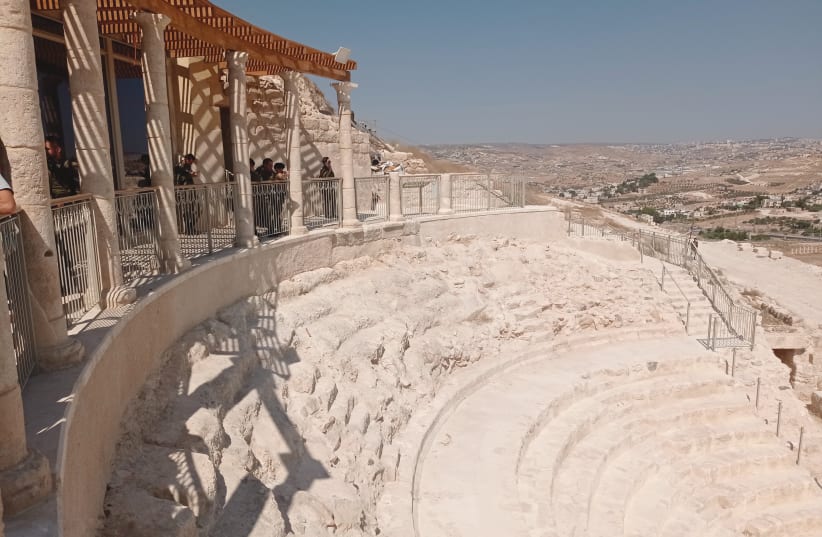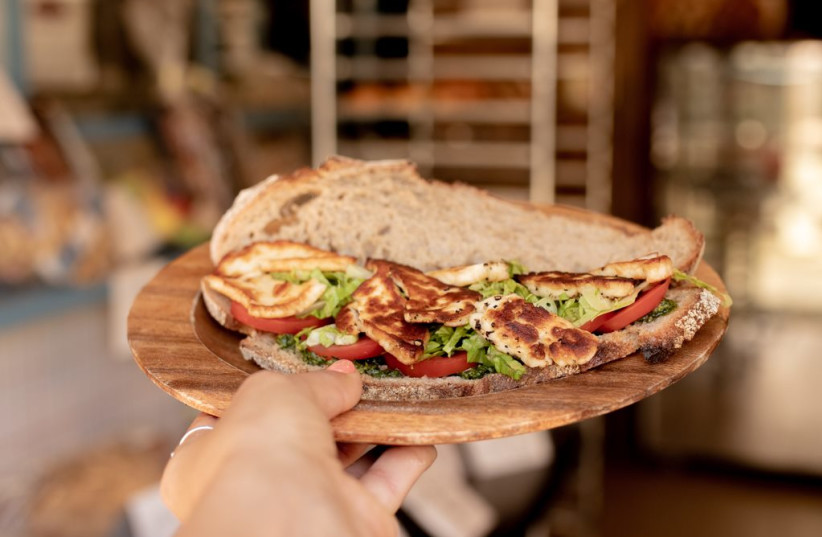When was the last time you visited that conical hill in the West Bank near Jerusalem called Herodion? If it’s been more than six months, it’s time for another visit as there are new things to see, including Herod’s theater which was previously off-limits to tourists.
Herodion, the only one of King Herod’s palaces that actually bears his name, is just 12 km. south of Jerusalem, and 5 km. southeast of Bethlehem. The site is in Area C of the West Bank, meaning it is under complete Israeli control. Along the way from Jerusalem, there are numerous red signs warning drivers not to leave the road and go into Area A (the area under full Palestinian control).
Archaeologists say that Herod decided to bury his palace before his death in 4 BCE so it wouldn’t compete with his tomb at the site. That decision preserved the 300-seat theater and foyer with brightly colored panels in green, auburn and black.
“This is my new crusade,” tour guide Shulie Mishkin told a group of tourists she brought to Herodion, most of whom live at least part-time in Israel. “If you want to talk about historical national parks, at the moment this is the top one in Israel in terms of the technology, what they’ve done and how they’ve restored things. It’s just amazing.”
Along with the new theater are three short movies about the life of King Herod. One is shown in the room where Herod hosted Marcus Agrippa, the second-in-command to Caesar Augustus, in 15 BCE. While parts of the rooms have been restored there are still parts of the original frescoes including drawings that copy open windows in the style of the time.
From the theater, which is perfectly preserved, you can walk up the monumental staircase to the top of the site. Once you do that, you have a stunning view of the entire area including the Dead Sea, the Jewish settlement of Tekoa, the Palestinian village of Tukua and Jerusalem.
Mishkin said Herod carefully chose the location of his palace.
“We are in this area that’s between the Judean Mountains and the Judean deserts,” Mishkin said. “In Hebrew it’s called ‘sfar hamidbar,’ the frontier, or the edge of the desert. It’s not quite the desert but right next to the desert. In terms of security, the desert means nomads, bandits, animals, the sfar is the area you need to protect or defend.”
Before leaving Herodion make sure to walk through the tunnels that were used as a water system during the Bar-Kochba Revolt against the Romans. The tunnels are punctuated by large water cisterns. Simon Bar-Kochba said that Herodion was his secondary headquarters and there is archaeological evidence for the revolt throughout the tunnels. It’s a steep climb down through the tunnels to the exit but it’s cool and pleasant on a hot summer day.
Most visitors continue from Herodion on to Jerusalem. But there’s someplace closer (just a few minutes drive from Herodion) that’s worth a visit – the Jewish settlement of Tekoa. Tekoa is most famous today as the home of the Tekoa Farm, which produces high-end mushrooms like oyster mushrooms, shitake and King Forest mushrooms. From the settlement, especially Tekoa Daled, there are stunning views of the Judean desert.
Tekoa is unique in many ways. It is mixed, meaning it has both observant and secular Jews. It has a hippie vibe, and tries to establish ties with its Arab neighbors, inspired by the settlements’ longtime rabbi, Menachem Froman, who cultivated ties with leaders of the Islamist Hamas movement, which the Israeli government sees as a terrorist organization, until his death in 2013.
It also has a lot of artists, with one of ten adults engaging in some type of artistic pursuit, according to Tehiya Bodinger, director of the newly opened Tekoa Artists Center, an NGO.
“We all have a connection to the place we live and to nature,” she said. “And we wanted to do something with all of the human potential we have here.”
The Artists Center has just opened a new complex of buildings next to the mushroom farm, with studios for artists making everything from jewelry to musical instruments. You can visit the studios and speak with the artists who are pushing the boundaries of traditional art.
In a separate building is the large studio of Jean Pierre Weill, where you can see 3D paintings on glass with gorgeous bold colors. It is unlike anything I’ve seen before and well worth a visit.
GETTING RENERGIZED
If you’re traveling with kids, you’re used to periodic whines of “I’m hungry” that can only be staved off temporarily by Bamba or ice cream. When it’s time for real food, check out Lehemoshe in Tekoa. Owned by Moshe Popovitch, who is also the chef, the restaurant offers sandwiches, salads, breads and excellent pizza. The Forest Pizza (NIS 55 for a medium, NIS 88 for a family size) had a white sauce, truffles, three types of mushrooms and mozzarella cheese. The Green Pizza (NIS 52/85) had a white sauce, fresh spinach, lots of broccoli, garlic, and Manchego cheese.
All of the breads are baked in-house and served with dips. If you’re watching your weight there are seven salads to choose from including a halloumi salad with fried halloumi cheese (NIS 48) and a sweet potato salad (NIS 48)
Popovitch says he has a mehadrin certificate even though some of his products are more expensive because he wanted everyone to feel comfortable eating there.
The writer was a guest of the restaurant.

